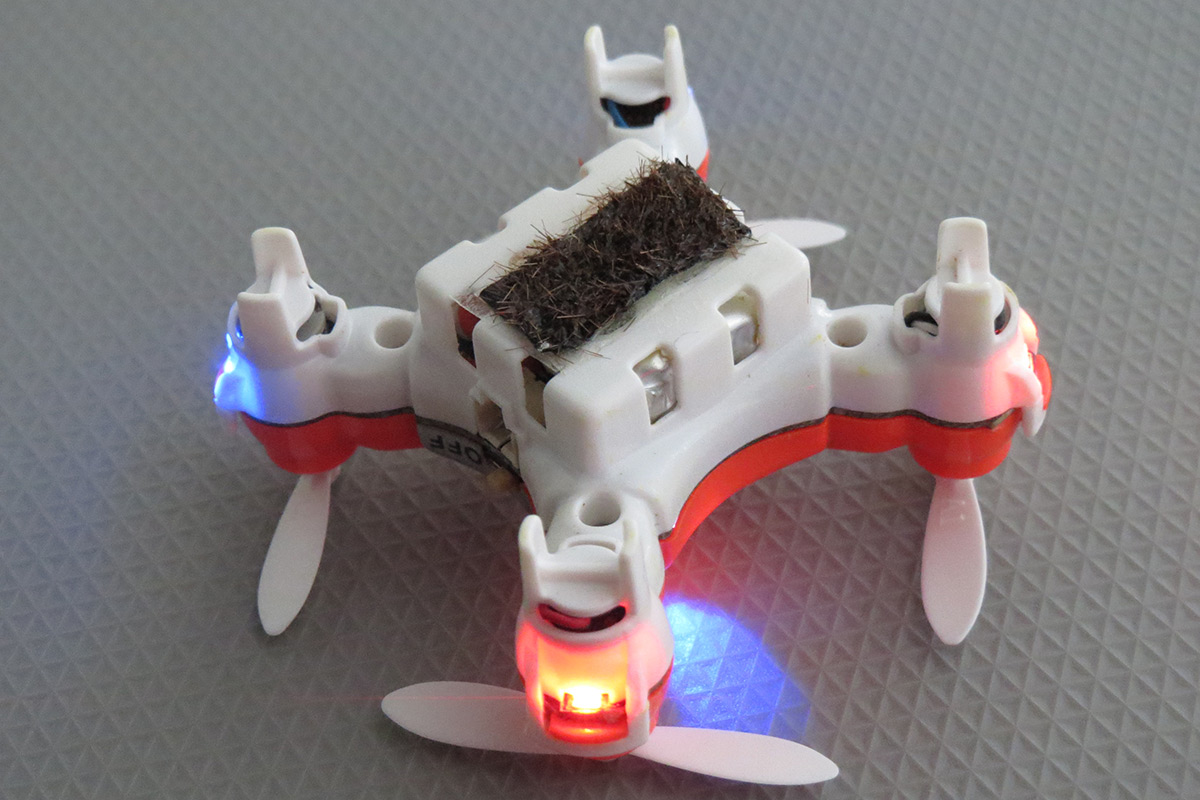 |
| Robotic pollinator Photo and video: Miyako et al. |
Can you imagine a world in which our crops and flowers are pollinated by autonomous drones the size of bees? Researchers at Japan's National Institute of Advanced Industrial Science and Technology believe this reality could be closer than we may think due to staggering declines in bee populations around the world.
Eijiro Miyako and his colleagues have used the principle of cross-pollination to engineer a bioinspired robotic pollinator, which can mimic the functionality of real bees, reports an article published in Science Direct. Measuring 4 centimeters wide and weighing a mere 15 grams, each drone is equipped with a strip of horsehair coated in an iconic liquid gel, allowing it to pick up pollen from one flower and deposit it in another.
"GPS, high-resolution cameras and artificial intelligence will be required for the drones to independently track their way between flowers and land on them correctly, " said Miyako.
While other methods sometimes prove to be more practical in some applications, bioinspired technology offers unique solutions to a wide variety of complex problems across numerous industries, and research is advancing.
Bioinspiration, Biomimetics, and Bioreplication VII, a conference focused on research and technology influenced by natural biological processes found in a variety of plants and organisms, will feature reports on research for several applications areas.
The conference is one of 11 being presesnted at SPIE Smart Structures/Nondestructive Evaluation 25–29 March in Portland, Oregon.
Among the presentations, David Hanson of Hanson Robotics, Ltd., will report in an all-conference plenary talk on research investigating how conventional motors limit bioinspired robotics and how electroactive polymer (EAP) actuators and sensors improve simplicity, compliance, and physical scaling in motors driving robotics. Hanson will also describe bioinspired advantages in robotic locomotion, grasping, manipulation, and social expressions, and present a roadmap for EAP actuators in bioinspired intelligent robotics.
In "Foldable drones: from biology to technology," Dario Floreano, Stefano Mintchev, and Jun Shintake of the Swiss Federal Institute of Technology in Lausanne will discuss the advantages and current limitations of adaptive morphological capabilities in drones.
Foldable wings enable better transition between aerial and ground locomotion, advancing the development of multimodal drones for extended mission envelopes. Currently, the potential of foldable drones is limited by the use of conventional design strategies and rigid materials. Tackling this challenge includes the development of structures that can become soft during morphing and stiff during regular operation by using origami structures or variable stiffness materials such as EAPs.
Folding, crawling, gripping -- to save lives
In other work drawing inspiration from nature, Michael
Tolley of the University of California, San Diego, reported last August at SPIE
Optics + Photonics on his team’s work in creating small robots capable of folding,
gripping, or crawling through small spaces.
The goal is to create smart robots
capable of working in uncontrolled environments, such as search and rescue missions
or inhospitable locations, Tolley said.
One inspiration came from a
particular seed pod in a very dry area of the world. The pod unfolds when the
humidity is just right, releasing seeds.
In another capability, an ant-inspired gripper starts as a
2-D piece of layered plastic and folds into a useful little robot capable of
moving objects. Rather than fold the robots by hand, Tolley’s research team developed
layered structures that self-fold into pre-printed shapes when heat is applied.
Adding localized heating to the structure allows for sequential folding;
heating the structure in one area, then the next area leads to self-folding
structures – even furniture.
Typical robots are made of material
too hard and tough to be flexible. However, using silicone elastomers,
Tolley created a soft-bodied robot – inspired by soft-bodied octopuses that are
capable of squishing through very small spaces – that could tolerate heat,
water, and getting run over, all while being flexible and capable of crawling
along using inflatable pneumatic tubes. This soft-bodied robot may come to
rescue earthquake victims one day.
Tolley's group will present on "Fluid electrodes for submersible robotics based on dielectric elastomer actuators," at SPIE Smart Structures/NDE in the conference on EAP Actuators and Devices.
Guest blogger Elizabeth Bernhardt, research assistant in nonlinear optics at Washington State University, reported on Michael Tolley's research from 2016 SPIE Optics + Photonics.

Comments
Post a Comment